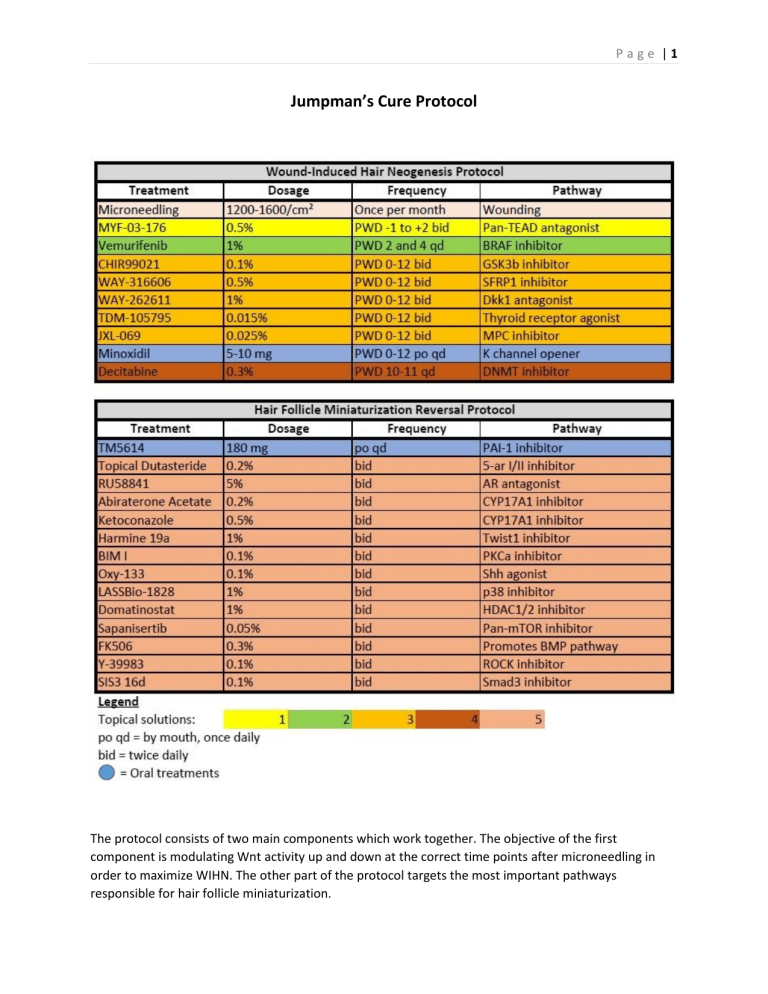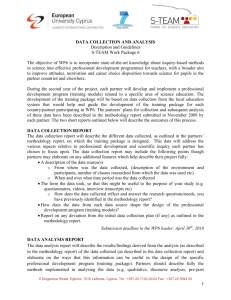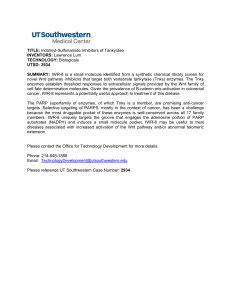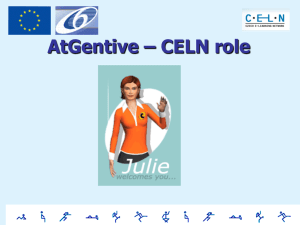
Page |1 Jumpman’s Cure Protocol The protocol consists of two main components which work together. The objective of the first component is modulating Wnt activity up and down at the correct time points after microneedling in order to maximize WIHN. The other part of the protocol targets the most important pathways responsible for hair follicle miniaturization. Page |2 I will begin with microneedling. Follica has put a lot of resources into investigating wounding protocols, so it would be foolish not to make use of the lessons they’ve learned. In my own experience, the methods they’ve landed on work better than any other wounding methods I have tried. The primary lesson learned is that the density of wounds determines the amount of regrowth rather than the severity of the wounds. The optimal density range for WIHN is 1200-1600 needle strikes per cm², and this should extend one to two centimeters into haired scalp. The purpose of that is to stimulate quorum sensing from healthy follicles to miniaturized follicles. The other important point is the depth. The optimal depth is 0.8mm, but I round up to 1mm due to having hair in the way. Wounding any deeper than this increases the risk of scarring, and does not produce better results. Having said that, a 1.5mm dermaroller is acceptable because it doesn’t penetrate as deeply as a motorized device. Quorum sensing Now onto the mechanisms behind WIHN. Among the most important are Wnt, Shh, and mechanotransduction. Wnt activity must be high during early wound healing in order to generate new hair follicles. However, it must be reduced during late wound healing in order to prevent fibrosis. Wnt must be activated three days post wounding up until it reaches a peak 12 days post wounding. Then it must be suppressed by 15-16 days post wounding. Sustained epithelial Wnt activation will prevent hair follicle formation, and cause scarring instead. However, Shh activation during late wound healing overrides the fibrotic fate despite sustained Wnt activation. OXY-133 potentiates endogenous Shh Page |3 signaling. While this alone will not upregulate Shh enough to override the fibrotic process, it may help with reducing scarring. Shh is also involved in specification of transit amplifying cells during early anagen. The downside is that Shh inhibits Smad1/BMPs which are necessary in later stages of follicular development, and involved in HF miniaturization. Promoting endogenous Shh should not have a substantial effect on this compared to other compounds which will upregulate the BMP pathway, so I may use OXY-133 on a daily basis. Wnt activation during regenerative and fibrotic healing The next important factor in promoting a regenerative fate after wounding is suppressing the mechanotransduction pathway. This pathway is activated by YAP1 binding to TEAD1/2/3/4. It represses TRPS1 and Wnt signaling, preventing regeneration of hair follicles, resulting in scarring instead. Mechanotransduction must be low, and Wnt high, in order to promote hair follicle formation. Based on the verteporfin experiments it is sufficient to knockdown the mechanotransduction pathway at the time of wound creation. I see no harm in extending that out a few days or even 10 days, so I will begin with using the TEAD inhibitor from one day before wounding through the second day after wounding. I will start the day before wounding to make sure the compound has enough time to be absorbed and accumulate, since it won’t be injected like verteporfin. Page |4 YAP high/Wnt low causes scar formation. The inverse promotes regeneration EGF pathway inhibition increases DP cell coalescence during early morphogenesis, days 2-4. Application of a BRAF (part of EGF pathway) inhibitor on days 2 and 4 post-wounding increases Wnt signaling and hair neogenesis. I will add the BRAF inhibitor, vemurifenib, on days 2 through 4 post-wounding. Vemurifenib increases Fzd7 Wnt receptor expression, so I may switch to using the BRAF inhibitor daily at some point. I will not do that from the start since BIM I should normalize EGF signaling. JXL-069 promotes one important aspect downstream of Wnt signaling, triggering anagen entry by promoting aerobic glycolyis which increases cell metabolism, promoting anabolic reactions that stimulate cell proliferation. This process is triggered downstream of ADRB2 adrenergic receptor activation, which is activated by sympathetic nerves which lose their connection to the bulge stem cells in fully miniaturized hair follicles. It should be noted that hair follicles still enter anagen without stimulation by adrenergic receptor beta, but it is significantly delayed. Using this drug could stimulate cellular metabolism, promote anagen entry and perhaps improve WIHN. It might be used daily, though there is concern that ovarctivation of HFSCs and melanocyte stem cells can deplete them, which is another reason to limit Wnt agonist use to the first 12 days after wounding. One caveat is that aerobic glycolysis is stimulated by Myc, which is upregulated in AGA. TDM-105795 promotes Wnt and Shh activity by activating the thyroid receptor-beta. Overactivation of thyroid hormones results in hair loss, so this will also be limited to the first 12 days after wounding in order to promote Wnt and Shh, and to stimulate anagen entry. The other drug everyone is familiar with Page |5 is minoxidil. It is well-studied for promoting WIHN. It could be used daily, but I will limit it too as it may contribute to overactivating Wnt during late wound healing. Decitabine is a DNMT inhibitor. It blocks DNA methylation which regulates gene expression. In mice, topical application for two days at scab detachment, usually around PWD10, increases hair regeneration up to 8-fold. This increases expression of Wnt genes at the cruicial time when Wnt signaling must be at its highest in order to promote HF regeneration. I will apply decitabine for just two days, exactly 10 and 11 days after microneedling. WIHN after 2 days of decitabine application following scab detachment Finally, there are three direct Wnt promoters that I will use during early wound healing to stimulate neogenesis. The first is CHIR99021, which inhibits GSK3a/b that inactivates B-catenin. B-catenin is required for canonical Wnt signal activation. CHIR99021 activates Wnt broadly in every cell. This is not ideal as Wnt signaling should not be active in the outer root sheath of the hair follicle, and we don’t want to overactivate bulge stem cells. WAY-316606 is the second. This one inhibits SFRP1, which binds to Wnt ligands inactivating them. Lastly, I will use WAY-262611 or gallocyanine to inhibit Dkk1. Dkk1 binds to LRP5/6 Wnt co-receptors, preventing them from forming a complex with Wnt ligands and Fzd Wnt receptors. By targeting each of these, along with other meds to increase Fzd activity, we can maximize the Wnt activity required for WIHN. Since all of this only potentiates endogenous Wnt activity it should be safe. The most risky one would be CHIR99021. Additionally, the AR, highly upregulated in bald scalp, binds to and sequesters b-catenin, so AR antagonists can also increase Wnt activity and improve WIHN. That covers the WIHN segment of the protocol. If you don’t want to wound or don’t need regrowth, then you wouldn’t need that part of the protocol. The more hair loss you have the more important WIHN will be for you. Now to discuss the AGA stack. First on the list is TM5614. Everyone is aware of this, and knows that PAI-1 is upregulated in bald scalp, playing a significant role in AGA. It promotes mast cell activation and senescence which are important aggravating factors in AGA. It also inactivates ERK1/2. Page |6 Next we have four drugs targeting androgen signaling, which is the most important pathway in AGA. Dutasteride inhibits the production of DHT, while RU58841 blocks the androgen receptor from being activated by DHT or from binding to b-catenin. Abiraterone acetate and ketoconzole both inhibit CYP17A1 which is responsible for the synthesis of androgens in the scalp. BMP4 and Smads, which are covered by this protocol, also regulate CYP17A1. By targeting each part of the AR pathway directly we can more potently downregulate AR signaling in the scalp. We could also target AR co-factors which I may update the protocol for at a later date. I will also target AR by downregulating EGFR and TWIST1. Ketoconazole also has the benefit of inhibiting inflammation. The amount of minoxidil-induced hair growth is inversely correlated with the amount of perifollicular inflammation. Another useful MOA for ketoconazole is inhibiting Myc. This is important for hair growth, but it’s overactive in AGA, and this contributes to a preference for sebocyte differentiation over hair shaft keratinocyte differentiation. Changes in steroid synthesis after loss of BMP4 are mediated by Smad pathway Now for the more exciting part of the protocol that people are less familiar with. Harmine 19a is a recently developed derivative of harmine that inhibits TWIST1. It is similar in potency to ADQ in vitro, 3x more potent than harmine, and hopefully without the cytotoxicity of harmine. Harmine inhibits DYRK1A and Wnt activity, which is bad for hair growth. This derivative has been modified substantially, so it may be more specific to TWIST1. If these issues are fixed, and it binds TWIST1 directly without binding Page |7 TWIST2, then it will work very well. It has a high drug-likeness score, and solubility should be decent. Although we may run into limits with achievable concentrations. There’s much that can go wrong with it, but I expect at least some degree of efficacy. TWIST1 is obviously crucial in AGA, perhaps with a greater potential for regrowth than the AR. Among its many other negative effects in AGA, TWIST1 binds the AR promoter to upregulate the AR. It mediates castration-resistant prostate cancer. Another protein associated with AGA which also upregulates AR is EGFR, and this is probably mediated in part through TWIST1 upregulation. EGFR becomes aberrantly activated in prostate cancer, and probably in AGA as well. IQGAP1 phosphorylates EGFR, which increases its activation. IQGAP1 is upregulated nearly 10-fold in bald scalp. PKCa is required for IQGAP1 phosphorylation of EGFR. Since we can’t degrade IQGAP1 directly, we can prevent some of its worst effects by blocking its postivie feedback loop with EGFR. To do this we can use BIM I, a PKCa inhibitor which is demonstrated to normalize EGFR signaling after IQGAP1 overexpression. EGFR inhibitors have been known to regrow scalp hair on bald men, so it is exciting to me to be able to normalize EGFR without downregulating it too much. Perhaps this can make the case reports of regrowth on EGFR inhibitors reproducible. Furthermore, androgen deprivation increases PKC activation in prostate cancer, and that upregulates TWIST1 and the AR to drive castration resistance. This is ameliorated by inhibition of PKC. PKC inhibition also enhances WIHN. Inhibition of PKC throughout wound healing contributes to restored hair follicle regeneration in adult skin cells. Application of IGF1/VEGF during only the first two days of wound healing also helped, which is odd because IGF1/VEGF promotes YAP1. I guess PKCi is sufficient to inhibit YAP1? Upregulation of MMPs also helped to restore regenerative capabilities in adult skin cells. TM5441 increases activation of MMPs. Hair regeneration in adult skin cells Page |8 There is yet another method by which AR is overexpressed in AGA. FOXO1 represses both AR and TWIST1, but it has been found missing in bald scalp. The combination of mTORC1/2 and HDAC1/2 inhibition has been found to upregulate and activate FOXO1. That’s where Domatinostat and Sapnisertib come into play. FOXO1 is crucial in regulating cell responses to metabolic stress, and sensitizing cells to growth factors. mTORC1 (FRAP1) has been found associated with AGA, and its substrate Akt, which inactivates FOXO1, appears to be hyperactivated in AGA. Aside from promoting expression of FOXO1, HDAC1/2 inhibition is separately shown to markedly increase DPC proliferation. The downside is that it increases apoptotic factor p53, but we are ameliorating this by inhibiting PAI-1 and p38. Thus this pathway is a doubly exciting target. EGFR Smad3 promote AR expression, FOXO1 represses it Y-39983 is a ROCK inhibitor. RhoA-ROCK is a pathway that is involved in the promotion of fibrosis, it is another mediator of PAI-1 and TWIST1 upregulation. It is activated by TGFb/Smad3, EGFR, and the noncanonical Wnt pathway, which is activated by IQGAP1. Smad3 is activated by TGFb1, and is highly overactivate in AGA. It mediates the negative effects of AR/TGFb1 on hair growth, and inhibiting it avoids the toxicity associated with targeting TGFb1 directly. SIS3 16d was recently developed as a highly Page |9 potent and selective, water-soluble inhibitor of Smad3. The ability to cut off most of the downstream effects of AR overactivation at this crucial point just downstream of TGFb, which is activated both upstream by AR and by feedback loops downstream, is very exciting. LASSBio-1824 is a p38a inhibitor. A feedback loop has been shown wherein TWIST1 promotes p38, while p38 promotes TWIST1, keeping them both upregulated. Inhibiting one or the other was shown to break the feedback loop. I don’t know that this is enough in AGA, as other factors may be more important for TWIST1 upregulation. Additionally, P38 activates SP1 which is responsible for a larger number of upregulated genes in AGA than any other transcription factor. FOXO1 downregulates SP1, so the protocol targets it from multiple angles. P38 also activates apoptotic factor p53, so LASSBio-1824 could also offset the increased p53 from HDAC1/2 inhibition. A recent study on Cyanidin 3-O-arabinoside found that it prevents DHT-induced DPC senescence by inhibiting p38-induced mitochondrial dysfunction. P38 increases mitochondrial calcium and ROS, and also activates HSP27 which stabilizes the AR P a g e | 10 Last but not least, we have FK506. This is a potent hair growth promoter similar to cyclosporine A, but more suited for topical application, and less toxic. Unlike CsA, it does not cause hair loss at higher concentrations. It promotes BMP4, which is a key regulator of differentiation that is absent in bald DPCs. BMP4 promotes the ID proteins which are so important for promoting hair shaft differentiation, and regulating TWIST1 dimer composition. ID1 overexpression results in thicker hair shafts, so upregulating it is very desirable. FK506 also inhibits the NFAT/calcineurin/PRLR pathway. FK506 promotes expression of BMP4 and activates the Smad1 pathway This protocol covers most of the critical junctions involved in hair follicle miniaturization, and everything is theorized to work synergistically to create new hairs and reverse minaturization. Out of the new compounds, those which might have a considerable effect as standalone treatments are BIM1, harmine 19a, FK506, SIS3 16d, Y-39983, domatinostat+spanisertib, and LASSBio-1824. If you aren’t interested in attacking all angles, you could select one from that group to use by itself, or combined with traditional treatments. Now you are ready to make this transformation:


